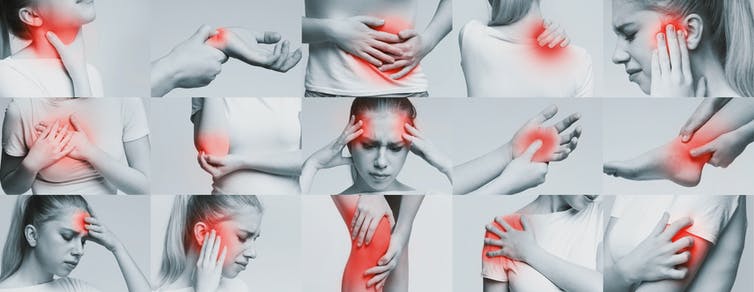
For at least three decades, researchers have gathered evidence that chronic stress puts pressure on the body to constantly adjust itself to restore physiological stability. This process is known as allostatic load and it creates a cascade of toxic metabolic activities that cause wear and tear on the body.
Allostatic load makes people vulnerable to various types of cardiac, gastrointestinal, endocrinological, immunological, neurological, metabolic and psychiatric problems.
Evidence is emerging to show that psychosocial and economic stressors influence health outcomes. But neither our physicians, nor our health-care systems, have the necessary tools and methods to integrate those social and economic factors into our diagnoses or preventive care.
Here is a personal example: Recently, I called my physician to report mysterious new pains. The thorough investigation and note-taking that followed would have been very useful if I had suffered a specific infection or injury, or if my blood work was imperfect. But I had symptoms that began slowly and were increasing in frequency with COVID- and work-related stresses.
The more she pressed for identifying how, where and when exactly my pains had begun, the more I felt guilty about my imprecise condition. When I joked that I just needed a month to hang out with Freud in the Alps, she suggested prescribing antidepressants. Falling back to self-blaming humour: “Maybe this is all psychosomatic,” I said.
Table of Contents
Stigma of unexplained pains
Far too many people have these experiences. The stigma and implicit biases against those who suffer chronic and unexplained pains (as complainers, malingerers and drug-seekers) are deeply rooted. They are gendered. They are racial, too.
While it is known that stress and social and economic disparities make people sick, physicians do not have the necessary tools to fix those causes of illness. At best, next to medications, they can offer psychotherapy, which remains inaccessible and unaffordable to most. Our health-care system is also unequipped to address the psychosocial determinants of health, which are situational and cultural, so they require more than a clinical approach to care.
For example, research on prescription of pain killers for racial and ethnic minorities shows that Black patients’ pain is undertreated. This reflects a lack of trust in the symptoms reported by those who may already be suffering other forms of socio-economic disparity. The 2020 death of Joyce Echaquan, enduring abuse and untreated pain in a Québec hospital, made it impossible to ignore the problem of health inequity any longer.
How combative approaches create stigma

(Shutterstock)
Since at least the publication of the first epidemiological study in 1662, we have been trying to predict and minimize causes of mortality. Science and technology are expected to help us win the battle against disease and disability. There is a particular structural worldview that shapes our current medical culture. It takes a combative approach to illness: it fights cancer, opioid epidemics, depression, diabetes and other conditions.
Implicitly, combative cultures value and reward winners. When we praise heroes (for example, 100-year-old people who enjoy active lives), we implicitly turn those who fail to losers. This is how patients and their caregivers co-create stigma and shame associated with chronic illness or even aging.
Fortunately, a shift has begun towards epistemic justice, which recognizes culturally appropriate practices and traditional knowledge, and patient-centred health-care practices are emerging. Indigenous leadership in de-colonizing health care will accelerate these efforts. For the health-care system to begin acting on those principles, a shift towards more flexible, qualitative and ecological research methodologies is needed.
Why play matters
In 1509, the Renaissance scholar Erasmus wrote In Praise of Folly to argue that play is an existential necessity that helps humans confront the inevitability of aging and death by becoming forgetful and carefree (like children).
Different forms of play are offered by therapists or hospices to facilitate communication over difficult or terminal health conditions.
In Steps To an Ecology of Mind (1971), anthropologist Gregory Bateson offered play as an experimental space for communication and learning from learning where people can simulate, interpret and evaluate the outcomes of their choices in a framed, but flexible, playground.
Indeed, play is a well-known research tool in developmental psychology, anthropology, economics and military strategies.
In the context of a global drive for digital tracking and profiling of potential causes of illness, my research colleagues and I have recently suggested that play offers an alternative way of approaching research and taking action in this digital ecosystem.
Prescribing play

(Shutterstock)
Twenty per cent of people suffer from chronic pain. What do we do when we cannot “win” the battle against pain? Often, drug prescriptions offer the cheapest and fastest-acting remedies. But they don’t always work and the side-effects can be disastrous. This is why consensus is growing among the World Health Organization members to invest in researching alternative ways of care.
In Homoludens (1938), historian Johan Huizinga showed that play is a uniquely human tendency to create imaginative aesthetics and rituals that give different meanings to the acts of satisfying biological needs such as shelter, food and safety.
Indeed, play can become a creative and knowledge-generating act. Creative art therapy or expressive writings can help track and control what causes pain.
Imagine if instead of pushing me to provide precise numbers for the intensity and frequency of my pain, I were allowed to use metaphor and be playful about explaining my symptoms and needs to my physician.
Imagine if the frame of caring for me was a bit more flexible to allow my doctor to prescribe a yoga regime, or help me explore a mindfulness program.
Imagine if clinicians incorporated Indigenous ways of knowing to LISTEN to pain (language, individual, share, teachable moments, engage and navigate).
Imagine if public health officials did not wait until chronic stress made the population prone to illness, and instead invested in happiness policies like those in the Netherlands, the country of Erasmus and Huizinga.
Turning play to action
When knowledge and care are lacking (for example, for women with endometrosis), social media becomes a space for knowledge generation. In Coping with Illness Digitally, health and digital communications researcher Stephan Rains illustrates that people connect to communities that offer information and care through shared experiences.
The COVID-19 pandemic illustrated the capacity of social media for generating data about coping with stress. However, if we are to be governed by numbers, we need a playground where we are safe and not passively surveyed. In a real playground, participants are not under surveillance, but are engaged in generating knowledge about psychosocial stressors that make them ill. Platforms such as Patients Like Me provide a blueprint for adding our narratives of stress-generated illnesses and coping strategies.
![]()
Najmeh Khalili-Mahani has received funding from FRQSC.
























